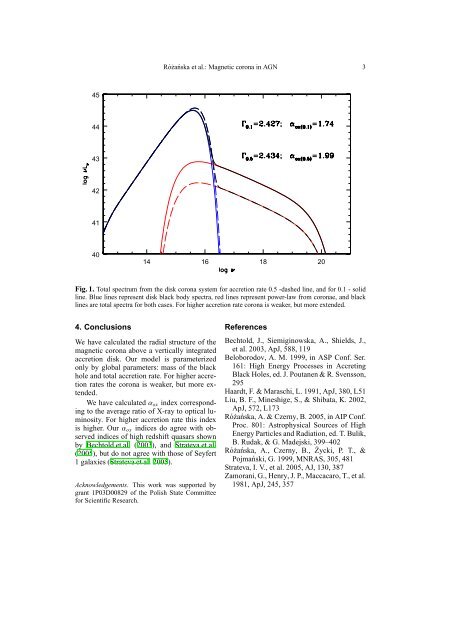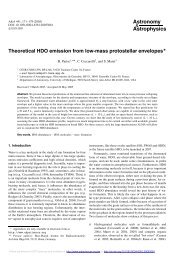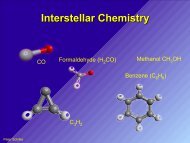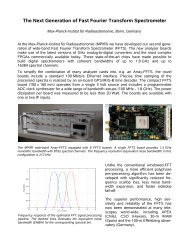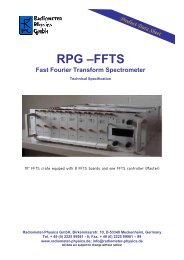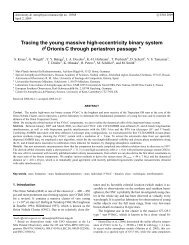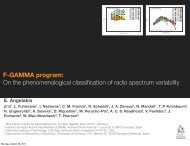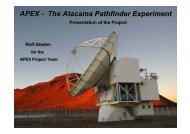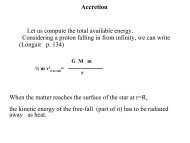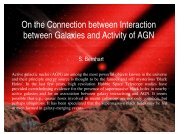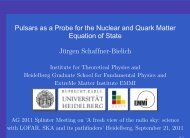Accretion disk with magnetic coronae in AGN
Accretion disk with magnetic coronae in AGN
Accretion disk with magnetic coronae in AGN
You also want an ePaper? Increase the reach of your titles
YUMPU automatically turns print PDFs into web optimized ePapers that Google loves.
Różańska et al.: Magnetic corona <strong>in</strong> <strong>AGN</strong> 3<br />
45<br />
44<br />
43<br />
42<br />
41<br />
40<br />
14 16 18 20<br />
Fig. 1. Total spectrum from the <strong>disk</strong> corona system for accretion rate 0.5 -dashed l<strong>in</strong>e, and for 0.1 - solid<br />
l<strong>in</strong>e. Blue l<strong>in</strong>es represent <strong>disk</strong> black body spectra, red l<strong>in</strong>es represent power-law from <strong>coronae</strong>, and black<br />
l<strong>in</strong>es are total spectra for both cases. For higher accretion rate corona is weaker, but more extended.<br />
4. Conclusions<br />
We have calculated the radial structure of the<br />
<strong>magnetic</strong> corona above a vertically <strong>in</strong>tegrated<br />
accretion <strong>disk</strong>. Our model is parameterized<br />
only by global parameters: mass of the black<br />
hole and total accretion rate. For higher accretion<br />
rates the corona is weaker, but more extended.<br />
We have calculatedα ox <strong>in</strong>dex correspond<strong>in</strong>g<br />
to the average ratio of X-ray to optical lum<strong>in</strong>osity.<br />
For higher accretion rate this <strong>in</strong>dex<br />
is higher. Ourα ox <strong>in</strong>dices do agree <strong>with</strong> observed<br />
<strong>in</strong>dices of high redshift quasars shown<br />
by Bechtold et al. (2003), and Strateva et al.<br />
(2005), but do not agree <strong>with</strong> those of Seyfert<br />
1 galaxies (Strateva et al. 2005).<br />
Acknowledgements. This work was supported by<br />
grant 1P03D00829 of the Polish State Committee<br />
for Scientific Research.<br />
References<br />
Bechtold, J., Siemig<strong>in</strong>owska, A., Shields, J.,<br />
et al. 2003, ApJ, 588, 119<br />
Beloborodov, A. M. 1999, <strong>in</strong> ASP Conf. Ser.<br />
161: High Energy Processes <strong>in</strong> Accret<strong>in</strong>g<br />
Black Holes, ed. J. Poutanen & R. Svensson,<br />
295<br />
Haardt, F. & Maraschi, L. 1991, ApJ, 380, L51<br />
Liu, B. F., M<strong>in</strong>eshige, S., & Shibata, K. 2002,<br />
ApJ, 572, L173<br />
Różańska, A. & Czerny, B. 2005, <strong>in</strong> AIP Conf.<br />
Proc. 801: Astrophysical Sources of High<br />
Energy Particles and Radiation, ed. T. Bulik,<br />
B. Rudak, & G. Madejski, 399–402<br />
Różańska, A., Czerny, B., Życki, P. T., &<br />
Pojmański, G. 1999, MNRAS, 305, 481<br />
Strateva, I. V., et al. 2005, AJ, 130, 387<br />
Zamorani, G., Henry, J. P., Maccacaro, T., et al.<br />
1981, ApJ, 245, 357


